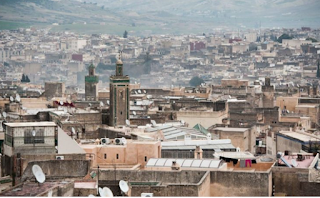
In Fez you can visit the house where Maimonides lived for a short while on the run from fundamentalists in his native Cordoba. Today, the house is crowded with artefacts representing a community on the verge of extinction. Its memory hangs by a thread, writes Cyril Garcia in Tribune Juive (with thanks: Paul)
But if today “the house” symbolizes the Jewish history of Fez and Morocco, it is especially because the main living room is full of religious pieces from the great synagogue of Fez, local Jewish schools, private individuals. A chandelier, a mezuzah, a bench with names of the faithful, a Torah scroll … Pieces more than 500 years old representing forgotten stories. With the departure of the Jews of Fez, all religious items stayed behind. Nothing has been brought out … everything is frozen in time and in the ground, for lack of buyers – because neither the state of Israel (where the “Moroccans” and their descendants remain the second community with 800,000 people after the “Russians”), nor the many Jewish associations of France, Navarre and worldwide have been interested in these treasures! Without the dedication of a 73-year-old Sarcelois native of Fez, where would this heritage, which goes beyond religious or community history, be, if not part of the historical heritage of humanity? How do they define a world where the past, memory and transmission have evaporated into the nimbus of the here and now?
Well guarded by an old Muslim, like the majority of Jewish sites in the country, its other guardian – its memory – tries by all methods to find a way out.
Descendants of “toshabim” (these Berber tribes Judaized in the time of North African Roman) or “megorashim” (exiled by force of Spain or Portugal after the Reconquista), the Jews have with Morocco a vivid history, full of passion. The majority were artisans, shopkeepers even peasants in the Atlas mountains. They occupied jobs devalued by Islam: cobbler, blacksmith etc. These dhimmis – second-class subjects – also possessed within the great dynasties – Merinides, Almohades, Almoravids -their representatives, their elites: rich traders, influential scholars or even doctors at the Court of different caliphs or sultans.
In fact, from top to bottom, the Muslims could not do without their Jews. As the historian Denis Rivet explains very well : “The Jews are neither within Maghreb society nor outside it, but between the two: neither the masters in town nor the pariah victims of dhimmitude. […] With Muslims, they live in a state of neighborhood and exclusion, complementarity and competition, proximity and differentiation. “
It is with the French protectorate that things change. The arrival of a new “industrial” economy destroys small trades and drives many Jews into poverty. The crisis of 1929 makes things worse. But like their co-religionists in France or Algeria, they set their sights on republican values. Benefiting from French schools opened in Fez or Casablanca (or intra-community structures of the Alliance Israelite Universelle), many Jews will take advantage of this breakthrough to excel in their studies and rise socially in “their” kingdom or sometimes abroad, especially in France. Zionism appeared; in the 1920s it attracted little interest . Mohammed V protected the Jews during the Second World War, according to tradition, but soon the events in the Middle East would have an impact on their fate. Pogroms there were, especially before the protectorate. In Casablanca and Fez, to be precise, the mellah was set ablaze on numerous occasions, athough some do not like to hear it. As early as 1033, the Zenetes had massacred Jews in the city. Closer to home, from 17 to 19 April 1912, the 12,000 residents of the mellah flee, pursued by the (Arab neighbours), because they were suspected of being too close to the colonial authorities, one month after the signing of the treaty. Forty-six Jews die. The mellah is on fire and many books are destroyed.

Leave a Reply